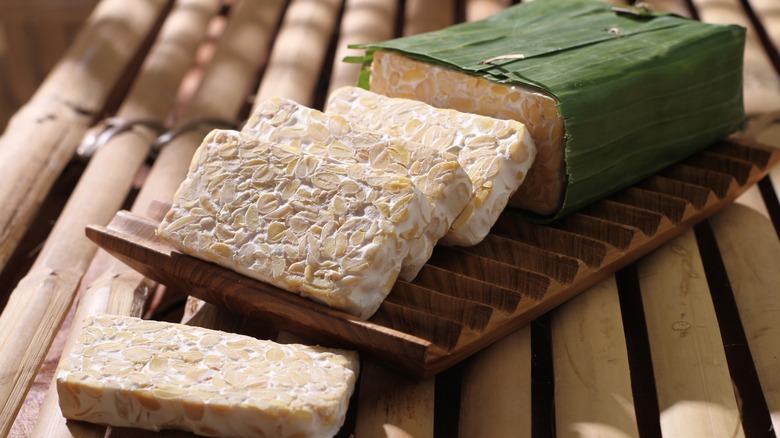The Bold Seasonings You Need To Make Tempeh Shine
Let's be honest, we've all heard it: Plant-based proteins don't live up to the hype, and those made from soy, in particular, often bear the brunt of this animosity. Tofu can't seem to shrug off the rep of being a finicky protein to work with, whereas tempeh is regarded with suspicion due to its unfamiliarity and seemingly bland taste. Bland flavors don't necessarily mean bland dishes, of course. Rice is great at taking on bold notes when spiced well, and the same is true for tempeh. Hit it hard with soy, sriracha, ginger, garlic — things that can add oomph.
The tricky part about tempeh though — and the reason why it may be perceived as bland — is knowing how to season and cook it. You may want to cook tempeh the way you would meat, but this soy product is an ingredient in its own right. This means tempeh needs to be seasoned and cooked according to its own characteristics.
For one, tempeh's spongey texture absorbs other flavors exceptionally well, which is why it shines with marinades and glazes as well as in liquid-based preparations. Most of all, however, tempeh lends itself well to bold and spicy flavors, so anything with chilies, hot sauces, alliums, and aromatics will bring out the best side of tempeh.
What is tempeh?
The first mentions of tempeh were found in 19th-century books on the history of the island of Java, indicating that the plant-based protein is likely of Indonesian origin. Although there are various kinds of tempeh that are made from all sorts of beans, seeds, and grains, most often, tempeh is made from cooked soybeans as is tofu. Unlike tofu, however, there's another step that goes into making tempeh: fermentation. By breaking down the phytic acid present in the soybeans, fermentation not only helps to make tempeh a lot easier to digest, but it also forms a layer of mycelium around the beans, giving tempeh its firm and chewy cake-like texture. However, this also means that tempeh needs to be cooked before consumed.
On its own, tempeh has a faint nutty, earthy, and umami flavor that is reminiscent of mushrooms with a hint of bitterness to it. Mainly though, tempeh has a fairly neutral taste and has no obvious flavor of its own. This is why tempeh can be a tad disappointing if eaten plain or under-seasoned, but this is also its biggest advantage: Tempeh can practically be a blank canvas to be seasoned with other bigger, better, and bolder flavors.
Add bold spices and seasoning
Because tempeh has Indonesian origins and is a popular protein in Asia, it goes with saying that it lends itself well to Asian seasonings. Tempeh is often considered bland because it lacks even salt, which is why just a simple sodium-filled soy sauce dressing can also make it flavorful. For a more layered marinade, consider using liquids like coconut milk, vinegar, and sesame oil; aromatics like ginger, garlic, makrut lime leaves, and shallots; as well as spicy condiments such as gochujang or sriracha.
Before getting down to the seasonings though, tempeh could do with an additional step: steaming. Steaming the tempeh helps it lose its tinge of bitterness after which it can be crumbled into soups, sauces, broths, and stews as it is — where it will absorb the flavors of the liquids — or it can then be tossed in a spice-filled marinade and pan-fried, grilled, or baked.
No matter how you choose to prepare it (like our sesame-peanut tempeh bowl), remember that bolder flavors are always better with tempeh rather than subtle ones. While you could get creative and season tempeh to replicate bacon and meaty burger patties or kebabs, when in doubt, look at Asian spices and seasonings or Indonesian recipes for inspiration as these are generally designed for tempeh to shine!



